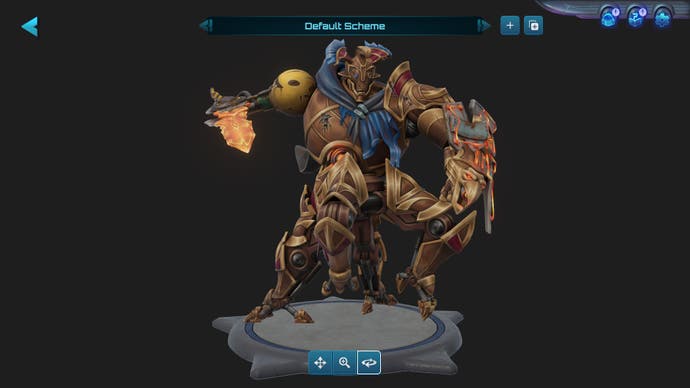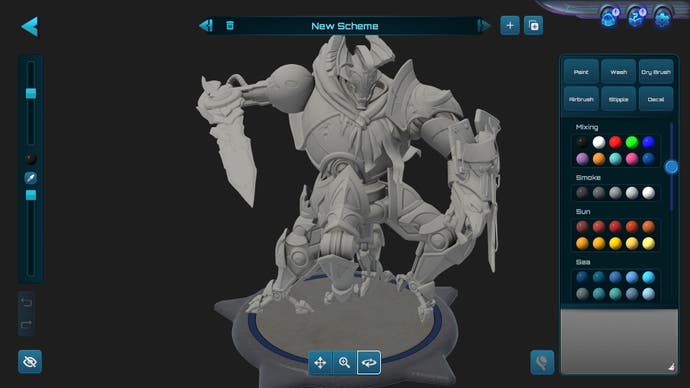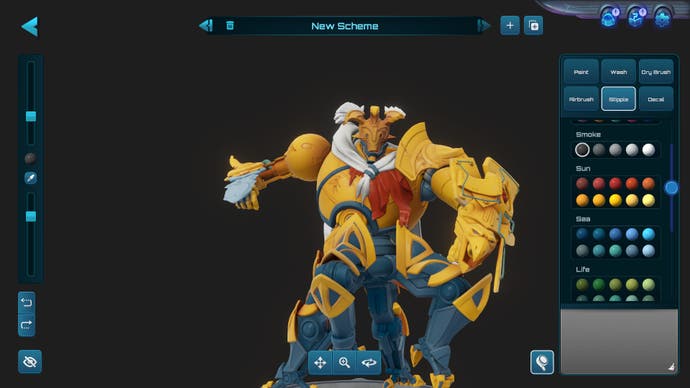Moonbreaker's take on Warhammer is awkward, but I like it
Still figurine some things out.
The first thing that hits me about Moonbreaker, the very-different-from-Subnautica game by Unknown Worlds, is how rigid and awkward it feels. It's strange because turn-based combat games are something I'm really familiar with, but Moonbreaker takes some getting used to though, and some of that I don't like, and some of it I really, really do.
It stems from Moonbreaker being a miniatures game. A friend called it Warhammer without the licence and that's exactly what it is. You collect and paint the figurines you use in battle; figurines are the whole point, so it's not surprising they behave like them and don't move around like animated characters. They are frozen in whatever dramatic expression they've been given: cheering, charging, taking aim, whatever. And when they move, it's as if someone picked them up and plonked them down somewhere else. And when they attack, it's like a child twizzled them in an emulation of the real thing. The figurines are voiced - there's a lot of energy and character in the game - but there's no escaping you're playing an adaptation of a tabletop game.
But the camera feels rigid too, fixed on rails you'll struggle to pull it off. It won't let you spin around the battlefield, viewing the action from varying angles, which I'd really like to do - if only to admire the figurines I've painted. But I also want it for gameplay reasons, so I can see bunched stand-offs more clearly. When large figurines stand near smaller ones it can be hard to see what's going on. As it is, I can only nudge the camera's rotation slightly before it pings back to a fixed angle, and it doesn't help much.
The zoom doesn't help much either. You can go right in close, almost to eye-level with the figurines, which looks very impressive, but when you pull back, it's as though the camera emulates a person standing up, shifting you above the table in a kind of top-down view. But it doesn't quite go high enough, and fails to clarify those confused bunches.
It's as though someone is holding my head too close to the action - I feel hemmed in and want to pull away. But I also think this claustrophobia is entirely intended, and that Moonbreaker is doing the equivalent of putting fighters in a ring or octagon, and forcing confrontations to take place. And in it, as in the sports that take place in those arenas, movement and positioning are key.
Keeping characters at distance, or closing the gaps between them, is half the tactical battle, and there's an entire subset of abilities based around it. Move sloppily and you will be punished, and heavily if you're playing a skilled opponent. And it doesn't help that the movement controls are quirky in their own right and take a while to get used to.

It adds up to an elbowy introduction, but live with it for a bit and let it settle, and something promising begins to emerge. I can't shake the comparison to HearthStone in how it plays - it's not a card game, obviously, but it behaves a bit like one.
In Moonbreaker, you have a hero figurine and each battle starts with only them on the battlefield - you and your enemy. And you earn one point of cinder (a kind of energy) you can use to play another figurine if you can afford one. In round two, you earn two cinder, and in round three, three cinder, and so on. Cinder is also what you spend on your figurine's special abilities, so the decision is whether to act now or call new figurines to build your power for the future.
On the surface, it's simple, but underneath, there are myriad ways to affect this formula. Figurines all have dangerous things they can do. Some get stronger the longer they're hit, whereas others immobilise figurines, locking them in place. Some grapple. Some poison. Some heal. Some barrage areas. And from them comes another dilemma: do you ignore the enemy figurines and go for the enemy's jugular, their champion, or do you manage their minions so you're not overwhelmed later on?
The answer, as you can imagine, is ever changing - sometimes it's elusive and you lose, sometimes it's apparent and you win. And every time you face a new opponent, the puzzle is refreshed - you can fight AI, incidentally, but fighting other players is where it's at. And again, like other card games, online matches are a social interaction-limited and therefore painless place to be.




The other significant side to Moonbreaker, as touched on above, is painting the figurines you collect. The game has an entire painting studio built in, and its magic feature, for me, is being able to lock paint to the layer I want to affect - say, one layer of armour. It's a bit like putting masking tape on everything else: I can slop paint around like Jackson Pollock and not mess anything up. And it makes it possible to paint an entire figurine - and they're quite detailed things - in half-an-hour if you're really pushing it. Another way of looking at it is: complete novices, like me, are invited to the painting party. And, naturally, if you already have some skill, you can use all the different brush types to create something more special.
The other thing about Moonbreaker I want to mention is the business model. It's pretty much a full-priced game (£25) but has loot boxes and a battle pass, although the battle pass is single-track and free. It's the loot boxes I don't understand. I thought they'd gone out of fashion in 2022 - even Overwatch, which started the trend, has ditched them.
I suppose they're meant to work like card packs, but they don't, not quite. They are how you expand your figurine roster, and each pack/box has three figurines in. There's a currency you can buy to buy packs/boxes with, and there's a different kind of currency you earn when you get duplicates, and you can spend this directly on figurines. There's also a 'guaranteed legendary' gauge that fills the more packs/boxes you open. But it feels old and of date, and makes me worry what the future of the game will look like with it.
But, this is early access, and ironing out these kinks is exactly what this period is designed for. I just hope Unknown Worlds is listening, because Moonbreaker has bags of potential, and with a few wise nips and tucks, it could be great.


